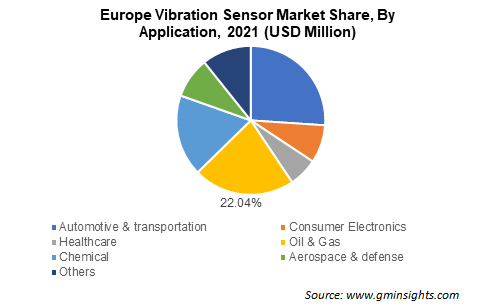Home > Semiconductors & Electronics > Sensors > Vibration Sensor Market
Vibration Sensor Market Analysis
- Report ID: GMI5191
- Published Date: Jan 2022
- Report Format: PDF
Vibration Sensor Market Analysis
The accelerometer segment held 45% of the market share in 2021 and is projected to witness 8.5% growth rate through 2028. The growth is driven by high-end features such as high accuracy, low-cost implementation, durability in harsh conditions, and linearity in a wide frequency range. Accelerometers are majorly used to monitor the health of rotating components in industrial machinery such as pumps, turbines, and compressors. Several prominent players in the industry are extensively focusing on innovating more durable products to gain a competitive edge in the market.
The analog output segment dominated more than 60% of revenue share in 2021 and is estimated to attain a CAGR of 6.5% till 2028. Vibration sensor with analog output offer several advantages such as improved sensitivity, wide range measurements, low-cost installations, and fast time to market. These sensors are majorly adopted in smart home security applications such as home care kits, security alarm systems, and building management solutions. This has encouraged OEMs to develop analog vibration sensor to address the growing demand in home security applications, further fueling the industry expansion. Vibration sensor manufacturers are incorporating analog communication interfaces into their sensors to provide efficient vibration monitoring in smart home appliances.

The oil & gas segment accounted for 20% of the market share in 2021 and is poised to expand at more than 7% by 2028. The business growth can be credited to numerous benefits such as low maintenance cost, increased production efficiency, and improved reliability during extraction and oil processing in refineries. In the oil & gas industry, vibration sensor are used to monitor the performance of various machines such as generators, crane bearings, heat exchangers, and compressors. Several oil extraction companies are collaborating with tech companies to integrate advanced asset condition monitoring solutions to ensure production safety.

Asia Pacific vibration sensor market captured 45% of revenue share in 2021 and is poised to register growth of 8% during 2022 to 2028. The industry progression is owing to the growing government efforts to promote automotive-grade semiconductor manufacturing in the region. For instance, in March 2021, South Korea invested USD 176.8 billion to accelerate automotive semiconductor production in the country. It supports local companies to manufacture sensors, chips, wafers, and other semiconductor components. The government is aiming to address the global semiconductor shortage in automotive manufacturing.

